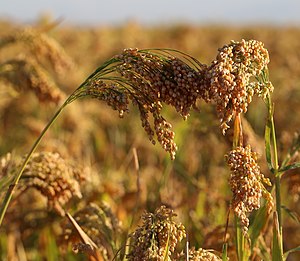Note: This is a project under development. The articles on this wiki are just being initiated and broadly incomplete. You can Help creating new pages.
Panicum miliaceum
Panicum miliaceum is a grain crop with many common names including proso millet, broomcorn millet, common millet, hog millet, Kashfi millet, red millet, and white millet. Archeological evidence suggests that the crop was first domesticated before 10,000 BCE in Northern China.
Uses
Parts Used
Chemical Composition
Resistant starch (22.95%, 0.23%, 2.02%, and 0.78%, respectively; P < .05). Lys was the first limit amino acid (AAS: 16.08%). Linolenic acid (61.74%) and oleic acid (22.16%) were the dominant fatty acids.[1]
Common names
| Language | Common name |
|---|---|
| Kannada | Baragu |
| Hindi | Chena, Barri |
| Malayalam | |
| Tamil | Pani varagu |
| Telugu | Variga |
| Marathi | NA |
| Gujarathi | NA |
| Punjabi | NA |
| Kashmiri | NA |
| Sanskrit | |
| English | Broom Millet |
Properties
Reference: Dravya - Substance, Rasa - Taste, Guna - Qualities, Veerya - Potency, Vipaka - Post-digesion effect, Karma - Pharmacological activity, Prabhava - Therepeutics.
Dravya
Rasa
Guna
Veerya
Vipaka
Karma
Prabhava
Habit
Identification
Leaf
| Kind | Shape | Feature |
|---|---|---|
| Simple | Linear in outline | Leaves occur along the entire length of each culm, becoming less abundant above |
Flower
| Type | Size | Color and composition | Stamen | More information |
|---|---|---|---|---|
| Simple | Ovoid | 4.5–5 mm. long | White when mature |
List of Ayurvedic medicine in which the herb is used
Where to get the saplings
Mode of Propagation
How to plant/cultivate
It has a wide adaptability and can be grown in climates which are too hot and dry, and on soils which are too shallow and poor for successful cultivation of other cereals.[3]
Commonly seen growing in areas
Photo Gallery
References
External Links
- Ayurvedic Herbs known to be helpful to treat Heart disease
- Herbs with Seeds used in medicine
- Herbs with common name in Kannada
- Herbs with common name in Hindi
- Herbs with common name in Tamil
- Herbs with common name in Telugu
- Herbs with common name in English
- Habit - Herbs
- Index of Plants which can be propagated by Seeds
- Herbs that are commonly seen in the region of Irrigation area
- Herbs
- Poaceae




